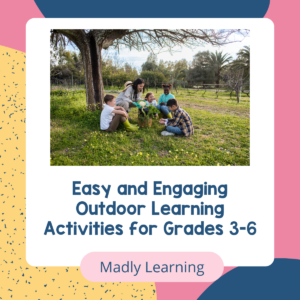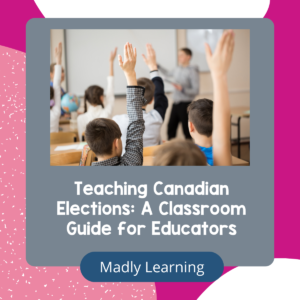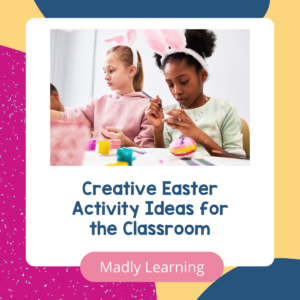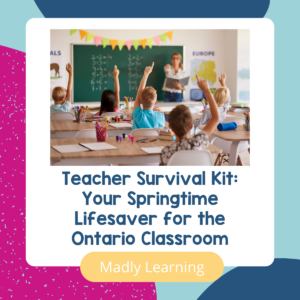“What is inquiry?”
So many times, the perception of inquiry is that students should be coming up with an inquiry question, and then developing this entire immense project that gets them to change the world.
In reality, inquiry doesn’t have to be quite so broad:
- an inquiry can be narrowly focused
- teachers can use an inquiry-based teaching perspective, lesson by lesson.

Teaching Has Changed
Inquiry-based learning, at its most basic level, is a paradigm shift from teaching through instructions to teaching with questions.
It is the framing of that understanding of inquiry-based learning that has helped me to transition from those traditional ways of teaching that I experienced myself as a student to what I do now.
My teachers growing up gave us information, we learned it and then were tested on it.
In a 21st-century classroom environment, and the world that we are living in, it is so drastically different from the world that we grew up. (…hello internet anyone…)
Today we need to teach our students to be
- adaptable
- Resourceful
- curious
Who Chooses
In an inquiry-based classroom. It’s not teacher choice that drives instruction, but instead, it’s student knowledge and curiosity.
 So we have to take the lead from our students. They are the reasons that we are in the classroom. They are the reasons that we are teaching.
So we have to take the lead from our students. They are the reasons that we are in the classroom. They are the reasons that we are teaching.
Our classrooms need to be more about them – a student-centred classroom and less about us – a teacher-centred classroom.
Now, that doesn’t necessarily mean the entire control structure or classroom management is necessarily student-centred because you still have to lead with confidence.
However, instructionally we need to have our instructions student-driven. Now with that being said, it also means that we are working within a system that requires us to teach certain curriculum expectations. So we need to look at the inquiry, not as a big global thing in our classroom where we just show up every day and ask our students what they want to learn.
Inquiry in Buckets
Instead, let’s look at inquiry as buckets if we are mandated to have different curriculum expectations that we need to cover.
So we will look at inquiry in buckets, buckets of language, math, science, social studies, the arts, Phys, Ed,
You can use inquiry-based teaching practices to cover the curriculum expectations.
Leading with Questions

Inquiry-based learning is more about leading through with questions and less about passive student learning. So what does that look like?
Remember that leading through questions doesn’t mean we don’t already know the answer. We guide students to ask the right kind of questions that will further the learning in the areas we are covering.
By leading with questions, our job is not to give students the answer, but to help to guide them on the journey that requires them to find their answers.
Students in an inquiry classroom need to be the ones in the driver’s seat. We, as teachers, are more the navigators.
In a world with information overload, they don’t need easily accessible information. What they do need is help to decide:
- what is or is not important.
- Navigate the amount of information that’s out there
- To find answers to their questions,
- solve the problems that they are presented with.
Micro not Macro
Now, too many times, inquiry-based learning is made to seem way up in the air. More abstract than concrete. This leads to the feeling that inquiry is just a free for all, where everyone’s doing their own thing, and the teachers are losing their minds trying to manage it all.
But I want to assure you that as a teacher, using inquiry can be a simple day to day task.
We have to look at the inquiry at the micro-level, not at the macro level.
So if we’re looking at inquiry at the micro-level,
- we’re going into our curriculum expectations
- we’re looking at what are the questions that students could ask
- what are the questions that our curriculum will lead us to
- how are we going to find the answers to those questions,
Then we start the process of giving our students a lesson by lesson, an inquiry type lesson that allows us to drive instruction while using student voice and choice.
We can use our role, not the information giver, but as the guide.
 Not all inquiry requires…
Not all inquiry requires…
“Teacher puts a question on the board, and students have a free for all to look for the research and try to find it.”
It also doesn’t mean that…
“every single student in your classroom is coming up with their questions and discovering their learning through this topic and coming up with this broad, broad inquiry project that they’re going to be doing and solving, and then they’ll eventually write a thesis. To explain exactly what they’ve learned.”
Instead…
I might start with a science topic about the human body.
 Easy Steps to Follow
Easy Steps to Follow
-
- Introduce A Topic: tell them what you are going to be learning about in a broad sense. Activate some prior knowledge if this exists.
- Get Them Curious: curate a set of manipulatives, pictures or other resources and create a wonder wall activity. Pick these objects specifically to those things that align with your expectations.
- Ask Questions: write them down, work with them, add to them and change them. Start getting initial questions and then organize them into categories.
- Create Learning Pathways: with your questions grouped, you can begin to see themes or lines of inquiry develop. Categorize these and create a learning goal or guiding question for this category.
- Plan activities: Plan activities that will help students answer their guiding questions.
It’s within those questions that we can seek the answers to those questions. And that’s where learning will happen.
Get Them Curious
 One of the ways that I get them curious is by curating a set of manipulatives, or a bunch of pictures that I can collect. I use this in a Wonderwall format. I collect these pictures, and I share those with my students.
One of the ways that I get them curious is by curating a set of manipulatives, or a bunch of pictures that I can collect. I use this in a Wonderwall format. I collect these pictures, and I share those with my students.
Now the objects that I pick are specifically targeted to match the curriculum expectations. Remember, in inquiry; I already know the answer. I know where we need to go, but it’s my job to guide them to get there.
So the items that I’m going to choose to make them curious are going to be things that will lead them along the path or onto the topics that I might want them to explore.
So in the human body, one of the central three systems that you’re going to be focusing on in that unit for grade five is going to be circulatory respiratory and digestive systems. So I will make sure that the objects that I put in my getting curious phase are going to be objects that allow my students to be interested in those things. So I will put pictures of the blood, and I will put pictures of a heart, and I will put pictures of the intestines, and I might even put pictures of poop because it gets kids wondering why it’s all in the same Wonderwall activity.
So if I’m starting with a topic, and I’m looking at what they need to learn, and I know where they need to go, but they don’t yet I’m going to put information in front of them that’s going to get them curious in that narrow topic.
Asking Questions
 Once I’ve got them curious. Now it’s time for me to get them to start asking questions. This allows me to assess what they already know as well as where they need to go.
Once I’ve got them curious. Now it’s time for me to get them to start asking questions. This allows me to assess what they already know as well as where they need to go.
- Show them the objects and ask them to do a SEE, KNOW, WONDER chart.
- Use this SKW chart to develop questions on sticky notes about things they want to learn more about
- Organize questions into categories.
Now, my experience in teaching this topic has told me that these categories of questions are going to be in specific buckets. This happens because of the way that I’ve structured the beginning of the Wonderwall activity.
So because of this, I can already have some lessons and ideas about where we’re going. This is why we can explore the different questions that they’re typically going to generate.
Be A Navigator
Once you have their questions, it’s now that you get to be the navigator.
So if they’re the driver, and they’re in the driver’s seat, you get to be the navigator, you’ve got the map. You just have to help them get to the end of where their knowledge is created.
So you’re going to give them hints and tips, and you’re going to walk them through different lessons and give them various opportunities to learn different concepts to allow them to discover the answers to their questions.
So instead of front-loading a lot of that information so they can regurgitate all of it.
- Instead, you’ll start with a question.
- Then you’ll give them the information they need to find the answer.
- Then ask them to reflect on what it is they’re learning, what they’ve learned, and how their learning has changed.

Teacher’s Role in Inquiry
Now the next three pieces of the inquiry process are really for the teacher and less for the student.
First, we need to be responsive to students in an inquiry-based classroom.
You need to listen to students to understand their perspective and where they’re coming from—knowing their background knowledge—understanding that each person’s approach learning is different.
How can you find common ground and find the average in there to kind of lead the group that direction?
- Listening to their thoughts and ideas
- Being open to their input on the learning
- Allowing voice and choice to be a part of your decision making as a teacher
- Allowing your students to have a say in what and how they learn something, (not necessarily what and how they learn because you have curriculum to cover)
Differentiation
 Allowing for choice allows for easier differentiation.
Allowing for choice allows for easier differentiation.
Some students want to learn hands-on activities. So make sure that some of the ways that you can get them to discover that learning is through hands-on activities.
Some students are good at reading or watching videos, can you provide both opportunities for students to gain knowledge through different ways of input.
Allow more than one way for students to show your learning to you.
There’s multiple ways that a group of students could demonstrate their understanding and show you how their knowledge has grown from the beginning to the end of an assessment test.
Assessment
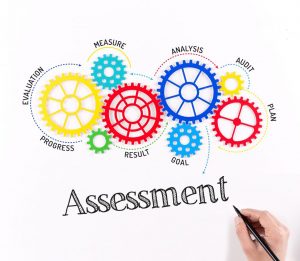 And the next thing that to focus on is looking at how exactly we assess inquiry learning.
And the next thing that to focus on is looking at how exactly we assess inquiry learning.
If we look at the curriculum that will help us to decide how their learning has changed, what did they know before, what knowledge have they gained now?
Ask yourself, have they gained a sufficient amount of knowledge?
Can you say that they have learned the content within the curriculum?
- Assess the knowledge gained not the product
- Clearly define the goal of learning that is to be achieved.
With different pathways in specific activities, students show you their learning differently from the student next to them.
Not every student is going to excel at a pencil and paper task.
Giving students the option to choose how they’re going to show their learning to you helps you to use student voice and choice in your classroom. It is student-centred, and it respects the fact that not every student is going to perform as well on some tasks as they are on others.
So by giving students the option to know themselves better as learners, and to choose the best method to show you what they have learned, will often get you a better quality overall of assessment data than merely requiring all students to do the same thing.
Finally
Teaching with inquiry doesn’t have to be complicated.
Teachers can use an inquiry-based teaching perspective, lesson by lesson.
- Start with a topic,
- Make them curious
- Get them asking questions
- Guide them on the path to gain new knowledge.
If you would like to learn more about using inquiry in your classroom, I would like to invite you to join the Madly Learning membership by signing up today for free.
As a member, you gain access to other training related to using inquiry in your classroom as well as getting many more inquiry-based free resources within the membership site.
To sign up and be a Madly Learning member, you can click here.

Want to hear more from Patti? Check out her blog or find her on Facebook and Instagram!

